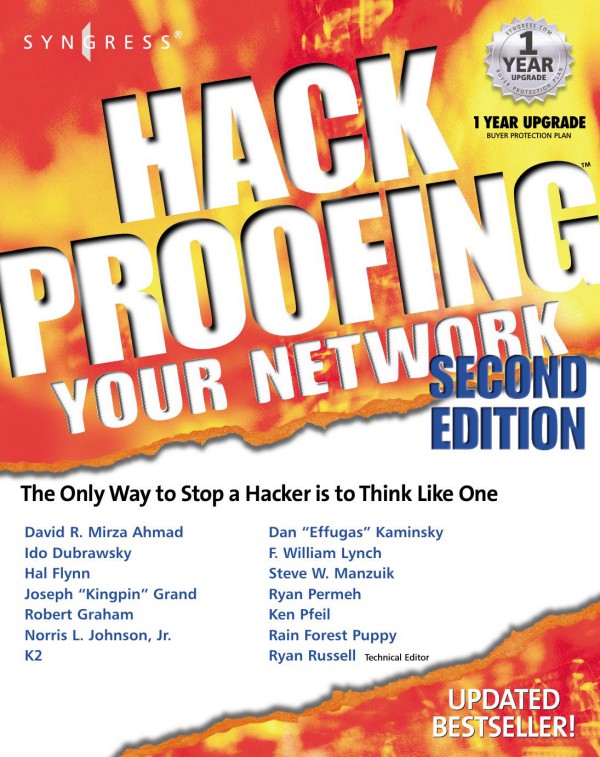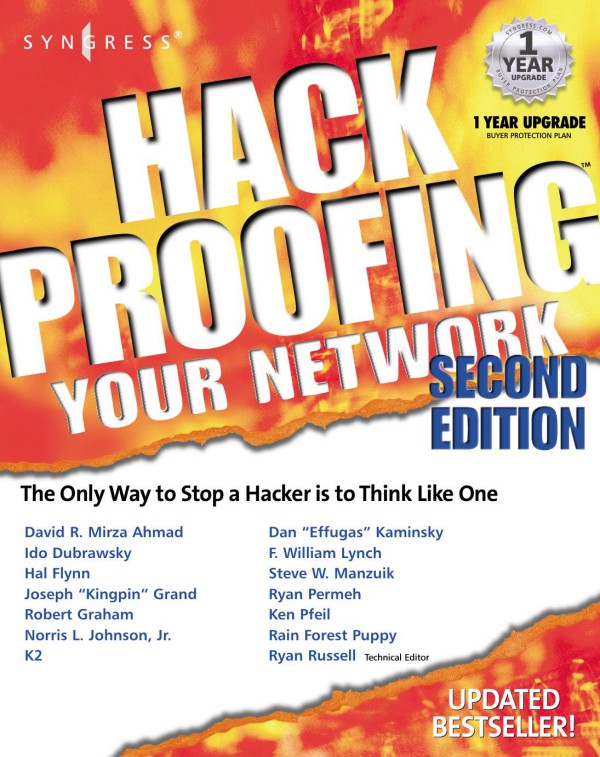Hack Proofing Your Network 2nd Edition by Ryan Russell, Dan Kaminsky, Rain Forest Puppy, Joe Grand, K2, David Ahmad, Hal Flynn, Ido Dubrawsky, Steve Manzuik, Ryan Permeh ISBN 1928994709 9781928994701
$50.00 Original price was: $50.00.$25.00Current price is: $25.00.
Authors:Ryan Russel; Rain Forest Puppy; Effugas; Et Al , Series:Cyber Security [223] , Tags:Hack Proofing Your Network; Second Edition , Author sort:Russel, Ryan & Puppy, Rain Forest & Effugas & Al, Et , Ids:Google; 9788177222388 , Languages:Languages:eng , Published:Published:May 2002 , Publisher:Dreamtech Press , Comments:Comments:This book is intended to teach skills that will be useful for breaking into computers. In this book we re just going to cover the techniques rather than reasons. Every other chapter has been brought up to date, retooled for an attack focus, tightened up and generally improved. One major change in focus for this edition is that we ve quit trying to explain ourselves. A great deal of time and effort was spent in the first edition trying to explain why knowing how to hack was a good idea.
Hack Proofing Your Network 2nd Edition by Ryan Russell, Dan Kaminsky, Rain Forest Puppy, Joe Grand, K2, David Ahmad, Hal Flynn, Ido Dubrawsky, Steve W. Manzuik, Ryan Permeh – Ebook PDF Instant Download/Delivery. 1928994709, 978-1928994701
Full download Hack Proofing Your Network 2nd Edition after payment

Product details:
ISBN 10: 1928994709
ISBN 13: 978-1928994701
Author: Ryan Russell, Dan Kaminsky, Rain Forest Puppy, Joe Grand, K2, David Ahmad, Hal Flynn, Ido Dubrawsky, Steve W. Manzuik, Ryan Permeh
A new edition the most popular Hack Proofing book around!
IT professionals who want to run secure networks, or build secure software, need to know about the methods of hackers. The second edition of the best seller Hack Proofing Your Network, teaches about those topics, including: · The Politics, Laws of Security, Classes of Attack, Methodology, Diffing, Decrypting, Brute Force, Unexpected Input, Buffer Overrun, Sniffing, Session Hijacking, Spoofing, Server Holes, Client Holes, Trojans and Viruses, Reporting Security Problems, Choosing Secure Systems The central idea of this book is that it’s better for you to find the holes in your network than it is for someone else to find them, someone that would use them against you. The complete, authoritative guide to protecting your Windows 2000 Network.
- Updated coverage of an international bestseller and series flagship
- Covers more methods of attack and hacker secrets
- Interest in topic continues to grow – network architects, engineers and administrators continue to scramble for security books
- Written by the former security manager for Sybase and an expert witness in the Kevin Mitnick trials
- A great addition to the bestselling “Hack Proofing…” series
- Windows 2000 sales have surpassed those of Windows NT
- Critical topic. The security of an organization’s data and communications is crucial to its survival and these topics are notoriously difficult to grasp
- Unrivalled web support at [email protected]
Hack Proofing Your Network 2nd Table of contents:
Chapter 1: How To Hack
- Introduction
- What We Mean by “Hack”
- Why Hack?
- Knowing What To Expect in the Rest of This Book
- Understanding the Current Legal Climate
- Summary
- Frequently Asked Questions
Chapter 2: The Laws of Security
- Introduction
- Knowing the Laws of Security
- Client-Side Security Doesn’t Work
- You Cannot Securely Exchange Encryption Keys without a Shared Piece of Information
- Malicious Code Cannot Be 100 Percent Protected against
- Any Malicious Code Can Be Completely Morphed to Bypass Signature Detection
- Firewalls Cannot Protect You 100 Percent from Attack
- Social Engineering
- Attacking Exposed Servers
- Attacking the Firewall Directly
- Client-Side Holes
- Any IDS Can Be Evaded
- Secret Cryptographic Algorithms Are Not Secure
- If a Key Is Not Required, You Do Not Have Encryption—You Have Encoding
- Passwords Cannot Be Securely Stored on the Client Unless There Is Another Password to Protect Them
- In Order for a System to Begin to Be Considered Secure, It Must Undergo an Independent Security Audit
- Security through Obscurity Does Not Work
- Summary
- Solutions Fast Track
- Frequently Asked Questions
Chapter 3: Classes of Attack
- Introduction
- Identifying and Understanding the Classes of Attack
- Denial of Service
- Information Leakage
- Regular File Access
- Misinformation
- Special File/Database Access
- Remote Arbitrary Code Execution
- Elevation of Privileges
- Identifying Methods of Testing for Vulnerabilities
- Proof of Concept
- Standard Research Techniques
- Summary
- Solutions Fast Track
- Frequently Asked Questions
Chapter 4: Methodology
- Introduction
- Understanding Vulnerability Research Methodologies
- Source Code Research
- Binary Research
- The Importance of Source Code Reviews
- Searching Error-Prone Functions
- Reverse Engineering Techniques
- Disassemblers, Decompilers, and Debuggers
- Black Box Testing
- Chips
- Summary
- Solutions Fast Track
- Frequently Asked Questions
Chapter 5: Diffing
- Introduction
- What Is Diffing?
- Why Diff?
- Looking to the Source Code
- Exploring Diff Tools
- Using File-Comparison Tools
- Working with Hex Editors
- Utilizing File System Monitoring Tools
- Finding Other Tools
- Troubleshooting
- Problems with Checksums and Hashes
- Problems with Compression and Encryption
- Summary
- Solutions Fast Track
- Frequently Asked Questions
Chapter 6: Cryptography
- Introduction
- Understanding Cryptography Concepts
- History
- Encryption Key Types
- Learning about Standard Cryptographic Algorithms
- Understanding Symmetric Algorithms
- Understanding Asymmetric Algorithms
- Understanding Brute Force
- Brute Force Basics
- Using Brute Force to Obtain Passwords
- Knowing When Real Algorithms Are Being Used Improperly
- Bad Key Exchanges
- Hashing Pieces Separately
- Using a Short Password to Generate a Long Key
- Improperly Stored Private or Secret Keys
- Understanding Amateur Cryptography Attempts
- Classifying the Ciphertext
- Monoalphabetic Ciphers
- Other Ways to Hide Information
- Summary
- Solutions Fast Track
- Frequently Asked Questions
Chapter 7: Unexpected Input
- Introduction
- Understanding Why Unexpected Data Is Dangerous
- Finding Situations Involving Unexpected Data
- Local Applications and Utilities
- HTTP/HTML
- Unexpected Data in SQL Queries
- Application Authentication
- Disguising the Obvious
- Using Techniques to Find and Eliminate Vulnerabilities
- Black-Box Testing
- Use the Source
- Untaint Data by Filtering It
- Escaping Characters Is Not Always Enough
- Perl
- Cold Fusion/Cold Fusion Markup Language (CFML)
- ASP
- PHP
- Protecting Your SQL Queries
- Silently Removing versus Alerting on Bad Data
- Invalid Input Function
- Token Substitution
- Utilizing the Available Safety Features in Your Programming Language
- Perl
- PHP
- ColdFusion/ColdFusion Markup Language
- ASP
- MySQL
- Using Tools to Handle Unexpected Data
- Web Sleuth
- CGIAudit
- RATS
- Flawfinder
- Retina
- Hailstorm
- Pudding
- Summary
- Solutions Fast Track
- Frequently Asked Questions
Chapter 8: Buffer Overflow
- Introduction
- Understanding the Stack
- The Stack Dump
- Oddities and the Stack
- Understanding the Stack Frame
- Introduction to the Stack Frame
- Passing Arguments to a Function: A Sample Program
- Stack Frames and Calling Syntaxes
- Learning about Buffer Overflows
- A Simple Uncontrolled Overflow: A Sample Program
- Creating Your First Overflow
- Creating a Program with an Exploitable Overflow
- Performing the Exploit
- Learning Advanced Overflow Techniques
- Stack-Based Function Pointer Overwrite
- Heap Overflows
- Advanced Payload Design
- Using What You Already Have
- Summary
- Solutions Fast Track
- Frequently Asked Questions
Chapter 9: Format Strings
- Introduction
- Understanding Format String Vulnerabilities
- Why and Where Do Format String Vulnerabilities Exist?
- How Can They Be Fixed?
- How Format String Vulnerabilities Are Exploited
- How Format String Exploits Work
- What to Overwrite
- Examining a Vulnerable Program
- Testing with a Random Format String
- Writing a Format String Exploit
- Summary
- Solutions Fast Track
- Frequently Asked Questions
Chapter 10: Sniffing
- Introduction
- What Is Sniffing?
- How Does It Work?
- What to Sniff?
- Obtaining Authentication Information
- Capturing Other Network Traffic
- Popular Sniffing Software
- Ethereal
- Network Associates Sniffer Pro
- NT Network Monitor
- WildPackets
- TCPDump
- dsniff
- Ettercap
- Esniff.c
- Sniffit
- Carnivore
- Additional Resources
- Advanced Sniffing Techniques
- Man-in-the-Middle (MITM) Attacks
- Cracking
- Switch Tricks
- Routing Games
- Exploring Operating System APIs
- Linux
- BSD
- libpcap
- Windows
- Taking Protective Measures
- Providing Encryption
- Secure Sockets Layers (SSL)
- PGP and S/MIME
- Switching
- Employing Detection Techniques
- Local Detection
- Network Detection
- Summary
- Solutions Fast Track
- Frequently Asked Questions
Chapter 11: Session Hijacking
- Introduction
- Understanding Session Hijacking
- TCP Session Hijacking
- TCP Session Hijacking with Packet Blocking
- UDP Hijacking
- Examining the Available Tools
- Juggernaut
- Hunt
- Ettercap
- SMBRelay
- Storm Watchers
- Playing MITM for Encrypted Communications
- Man-in-the-Middle Attacks
- Dsniff
- Other Hijacking
- Summary
- Solutions Fast Track
- Frequently Asked Questions
Chapter 12: Spoofing: Attacks on Trusted Identity
- Introduction
- What It Means to Spoof
- Spoofing Is Identity Forgery
- Spoofing Is an Active Attack against Identity Checking Procedures
- Spoofing Is Possible at All Layers of Communication
- Spoofing Is Always Intentional
- Spoofing Is Not the Same Thing as Betrayal
- Spoofing Is Not Necessarily Malicious
- Spoofing Is Nothing New
- Background Theory
- The Importance of Identity
- The Evolution of Trust
- Asymmetric Signatures between Human Beings
- Establishing Identity within Computer Networks
- Return to Sender
- In the Beginning, There Was… a Transmission
- Capability Challenges
- Configuration Methodologies: Building a Trusted Capability Index
- Desktop Spoofs
- The Plague of Auto-Updating Applications
- Impacts of Spoofs
- Subtle Spoofs and Economic Sabotage
- Down and Dirty: Engineering Spoofing Systems
- Spitting into the Wind: Building a Skeleton Router in Userspace
- Bring Out the Halon: Spoofing Connectivity Through Asymmetric Firewalls
- Summary
- Solutions Fast Track
- Frequently Asked Questions
Chapter 13: Tunneling
- Introduction
- Strategic Constraints of Tunnel Design
- Privacy: “Where Is My Traffic Going?”
- Routability: “Where Can This Go Through?”
- Deployability: “How Painful Is This to Get Up and Running?”
- Flexibility: “What Can We Use This for, Anyway?”
- Quality: “How Painful Will This System Be to Maintain?”
- Designing End-to-End Tunneling Systems
- Drilling Tunnels Using SSH
- Open Sesame: Authentication
- Basic Access: Authentication by Password
- Transparent Access: Authentication by Private Key
- Command Forwarding: Direct Execution for Scripts and Pipes
- Port Forwarding: Accessing Resources on Remote Networks
- Local Port Forwards
- Dynamic Port Forwards
- Remote Port Forwards
- When in Rome: Traversing the Recalcitrant Network
- Crossing the Bridge: Accessing Proxies through ProxyCommands
- No Habla HTTP? Permuting thy Traffic
- Show Your Badge: Restricted Bastion Authentication
- Bringing the Mountain: Exporting SSHD Access
- Echoes in a Foreign Tongue: Cross-Connecting Mutually Firewalled Hosts
- Not In Denver, Not Dead: Now What?
- Standard File Transfer over SSH
- Incremental File Transfer over SSH
- CD Burning over SSH
- Acoustic Tubing: Audio Distribution over TCP and SSH
- Summary
- Solutions Fast Track
- Frequently Asked Questions
Chapter 14: Hardware Hacking
- Introduction
- Understanding Hardware Hacking
- Opening the Device: Housing and Mechanical Attacks
- Types of Tamper Mechanisms
- External Interfaces
- Protocol Analysis
- Electromagnetic Interference and Electrostatic Discharge
- Analyzing the Product Internals: Electrical Circuit Attacks
- Reverse-engineering the Device
- Basic Techniques: Common Attacks
- Advanced Techniques: Epoxy Removal and IC Delidding
- Cryptanalysis and Obfuscation Methods
- What Tools Do I Need?
- Starter Kit
- Advanced Kit
- Example: Hacking the iButton Authentication Token
- Experimenting with the Device
- Reverse-engineering the “Random” Response
- Example: Hacking the NetStructure 7110 E-commerce Accelerator
- Opening the Device
- Retrieving the Filesystem
- Reverse-engineering the Password Generator
- Summary
- Solutions Fast Track
- Frequently Asked Questions
Chapter 15: Viruses, Trojan Horses, and Worms
- Introduction
- How Do Viruses, Trojan Horses, and Worms Differ?
- Viruses
- Worms
- Macro Virus
- Trojan Horses
- Hoaxes
- Anatomy of a Virus
- Propagation
- Payload
- Other Tricks of the Trade
- Dealing with Cross-platform Issues
- Java
- Macro Viruses
- Recompilation
- Shockwave Flash
- Proof that We Need to Worry
- The Morris Worm
- ADMw0rm
- Melissa and I Love You
- Sadmind Worm
- Code Red Worms
- Nimda Worm
- Creating Your Own Malware
- New Delivery Methods
- Faster Propagation Methods
- Other Thoughts on Creating New Malware
- How to Secure Against Malicious Software
- Anti-Virus Software
- Updates and Patches
- Web Browser Security
- Anti-Virus Research
- Summary
- Solutions Fast Track
- Frequently Asked Questions
Chapter 16: IDS Evasion
- Introduction
- Understanding How Signature-Based IDSs Work
- Judging False Positives and Negatives
- Alert Flooding
- Using Packet Level Evasion
- IP Options
- IP Fragmentation
- TCP Header
- TCP Synchronization
- Using Fragrouter and Congestant
- Countermeasures
- Using Application Protocol Level Evasion
- Security as an Afterthought
- Evading a Match
- Web Attack Techniques
- Countermeasures
- Using Code Morphing Evasion
- Summary
- Solutions Fast Track
- Frequently Asked Questions
Chapter 17: Automated Security Review and Attack Tools
- Introduction
- Learning about Automated Tools
- Exploring the Commercial Tools
- Exploring the Free Tools
- Using Automated Tools for Penetration Testing
- Testing with the Commercial Tools
- Testing the Free Tools
- Knowing When Tools Are Not Enough
- The New Face of Vulnerability Testing
- Summary
- Solutions Fast Track
- Frequently Asked Questions
Chapter 18: Reporting Security Problems
- Introduction
- Understanding Why Security Problems Need to Be Reported
- Full Disclosure
- Determining When and to Whom to Report the Problem
- Whom to Report Security Problems to?
- Deciding How Much Detail to Publish
- Publishing Exploit Code
- Problems
- Summary
- Solutions Fast Track
- Frequently Asked Questions
People also search for Hack Proofing Your Network 2nd:
hack proof
how to hack proof your computer
google hacking protection
4 hacks for prodigy
hacking protection
You may also like…
eBook PDF
Snell Clinical Neuroanatomy 8th Edition by Ryan Splittgerber ISBN 1496346750 9781496346759












